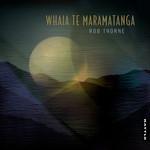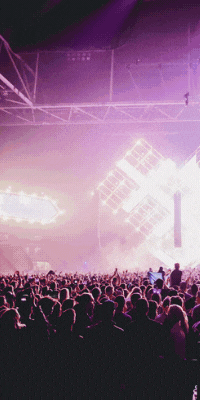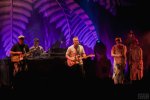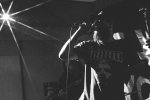Rob Thorne - Toi Puoro - Whāia te Māramatanga Album Review
 While attending Sounds Aotearoa 2012 (http://soundsaotearoa.com/) as a member of the press I had an epiphany. Someone had to find a way to make Maori music mainstream. My idea was Maori Industrial, a sort amalgamation of Nine Inch Nails and Te Reo. Sadly I’m not that man. The main setbacks for me are my European heritage and assuming that a niche genre would be enough to change the world, and sadly that’s all I have in my repertoire.
While attending Sounds Aotearoa 2012 (http://soundsaotearoa.com/) as a member of the press I had an epiphany. Someone had to find a way to make Maori music mainstream. My idea was Maori Industrial, a sort amalgamation of Nine Inch Nails and Te Reo. Sadly I’m not that man. The main setbacks for me are my European heritage and assuming that a niche genre would be enough to change the world, and sadly that’s all I have in my repertoire.
As a person of this nation, though not a descendant of this land’s first caretakers, I feel a sense of loss knowing that the music scene, at least the mainstream, is diluted by products made in America and the knock-offs that emulate them when New Zealand has its own voice and a diverse musical heritage.
This is at least part of the reason why I have a great reverence for Rob Thorne’s Whāia te Māramatanga. This is both an album, and an art piece and as I see it, a celebration of this country’s cultural past. Performed in its entirety with Taonga pūoro, the traditional instruments of the Maori, it’s not like anything you’re going to hear on Juice TV. But there is more to music than making a quick buck by selling your image to the highest bidder.
These instruments hold more purpose than a flute or a guitar, which are only used to look cool (not so much the flute) and make noise. Taonga pūoro were used in antiquity as a conduit between our physical world and the spiritual. Like other parts of the Maori culture, the use of Taonga pūoro diminished as the missionaries introduced Christianity. The focus turned to hymn, and the importance of the spiritual waned.
In this stage of human development are minds are starting to open again. People are beginning to understand the need for the spiritual world. For example, Mason Durie’s te Whare tapa wha Maorihealth model, something used in hospital settings today, places as much importance on Taha wairua (spiritual health) as it does Taha tinana (physical health).
I feel that this album addresses both worlds.
“Hope u like drone.”
My first listen I understood what Rob Thorne meant by this reference; the repetition of what to me seemed like the same tone. I expected Lustmord, but the only similarity I could draw at the time was the abridged version of Rundgang um die transzendentale Säule der Singularität from the Gummo soundtrack.
This album is nothing like either of those. There’s nothing quite like it out there.
Being instruments designed outside the scope of western music there are tonal peculiarities, little microtones, that we don't usually hear with an oboe or a flute perhaps. In the hands of Rob Thorne at least these instruments at times replicate the haunting tones of the kaikaranga when they hit that one note that makes the hair at the back of your neck stand up. The effect is the same.
“Soporific”
Sleep-inducing is how Rob Thorne described it to me. I’d prefer to say calming. The soundtrack to a lucid astral-projection. A trip, which is how I imagine it must feel for Rob Thorne performing these pieces live. Breathing is an important part of meditation, so using that breath to play an instrument used to commune with the gods can't be anything else.
It’s not the kind of music where one picks a favourite song. At the end of the day, if you are stuck in a certain genre then you won’t appreciate the music, but you can still appreciate the intention, provided you have a mind to reflect.
Revitalized for today with modern recording techniques, this album brings the music of the past back into our hands, so it won't be forgotten in time.
On the most basic level this album is an attempt to bring the instruments of the past with the technology of the future. Above that would be Rob Thorne's experience learning to use these traditional, spiritual instruments and performing with them, which as well as entertaining us, must be enlightening for him.
Even if you're not reached by the music, I suggest you check out Rob Thorne’s performance of Wahaoraon Youtube (www.youtube.com/watch?v=_3j3tt0DZVQ), and while you’re at it I also suggest the video of the putorino in Whanganui’s Durie Hill Tunnel (www.youtube.com/watch?v=_giZ8Crip8s). Both videos show the instruments in action, and the source of the different sounds you hear on the album.
About Rob Thorne - Toi Puoro

Finalist Best Maori Traditional Album, Waiata Maori Music Awards (2014).
Photo Credit: Emma Allen del Castillo
Visit the muzic.net.nz Profile for Rob Thorne - Toi Puoro
Releases
Other Reviews By Peter-James Dries
 AJA - Album Review: Kawai
AJA - Album Review: Kawai
13 Dec 2024 // by Peter-James Dries
Bilingual albums shouldn’t be special; they should be the norm. Or at least more common.
Read More...
 Ra Charmian - Album Review: Waiata Wairua
Ra Charmian - Album Review: Waiata Wairua
08 Oct 2024 // by Peter-James Dries
Waiata Wairua is an album that wouldn’t feel out of place performed in a late night jazz hall in some alternate history where the successes of the Maori battalion lead to a proliferation of Te Reo worldwide. The sort of interest that saw your dad singing in French in the 60's, when Mireille Mathieu was knocking about.
Read More...
 Ben Lloyd - Album Review: Leap of Faith
Ben Lloyd - Album Review: Leap of Faith
26 May 2024 // by Peter-James Dries
For over 30 years, this self-taught rocker from Mt Maunganui has been writing music. Now, for the first time since 2013, we finally get to hear his songs.
Read More...
 Yann Le Dorré - Album Review: The Circus is Closed
Yann Le Dorré - Album Review: The Circus is Closed
19 Dec 2023 // by Peter-James Dries
“We are Sex Bob-Omb and we're here to make you think about death and get sad and stuff!” - Scott Pilgrim vs.
Read More...
 Sanoi - Album Review: Echoes Of Home
Sanoi - Album Review: Echoes Of Home
25 Nov 2023 // by Peter-James Dries
Electronica offers no escapism for me. It’s more of what I already have.
Read More...
 Throng - EP Review: Decoherence
Throng - EP Review: Decoherence
20 Oct 2023 // by Peter-James Dries
You know that thing where the letter B has a personality, or words have textures and colours? That’s called synaesthesia.
Read More...
 Fortress Europe - Album Review: Old World
Fortress Europe - Album Review: Old World
10 Oct 2023 // by Peter-James Dries
Have you ever been torn between listening to Mozart or Periphery? Does Epica have too much of that darn singing for your tastes?
Read More...
 Yurt Party - Album Review: Yurt Party
Yurt Party - Album Review: Yurt Party
07 Sep 2023 // by Peter-James Dries
It sure isn't summer, and this is really not the Balkans, but Yurt Party’s new self-titled album refutes that. Back with another one of them Balkan rocking beats, Yurt Party’s debut is jazzy, erratic, and full of zest and energetic grooves, with flavour notes of ska, dub, and bergamot.
Read More...
Most Viewed Artists
Latest Galleries
NZ Top 10 Singles
- APT.
ROSÉ And Bruno Mars - DIE WITH A SMILE
Lady Gaga And Bruno Mars - BIRDS OF A FEATHER
Billie Eilish - TASTE
Sabrina Carpenter - I LOVE YOU, I'M SORRY
Gracie Abrams - ESPRESSO
Sabrina Carpenter - SAILOR SONG
Gigi Perez - LOSE CONTROL
Teddy Swims - A BAR SONG (TIPSY)
Shaboozey - GOOD LUCK, BABE!
Chappell Roan









 Report A Problem
Report A Problem

